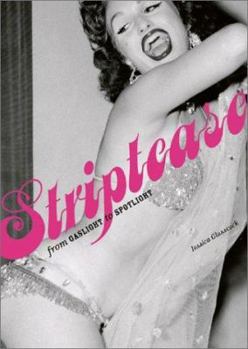Striptease: From Gaslight to Spotlight
This volume reveals the history of the striptease from its roots in popular stage shows to its wonderfully garish heyday. The book highlights such performers as Isadora Duncan, Ruth St Denis, Maud Allen, Loie Fuller, Gypsy Rose Lee, Ann Corio, Tempest Storm and Blaze Starr.
Format:Hardcover
Language:English
ISBN:0810945444
ISBN13:9780810945449
Release Date:September 2003
Publisher:Harry N. Abrams
Length:176 Pages
Weight:3.90 lbs.
Dimensions:0.8" x 7.6" x 10.6"
Age Range:13 years and up
Grade Range:Grade 8 to Postsecondary
Customer Reviews
1 rating
A Revealing and Lavish History
Published by Thriftbooks.com User , 21 years ago
Striptease, always shocking and amusing, has in addition become, well, quaint. It has been influential in stage, music, and movies, and in the relationship between the sexes. It comes as a surprise, then, that the publisher of _Striptease: From Gaslight to Spotlight_ (Abrams) could boast that the book is the only fully illustrated book available on the history of the subject. If this is indeed so, at least the one history is a memorable one. Jessica Glasscock, the author, has written a witty and fact-filled text that takes the history from the roots of striptease in the nineteenth century to its culmination and dormancy in the 1950's. Guys used to say about _Playboy_, "I only get it for the articles," and one could enjoy this book just for the text, but there are pictures, lots and lots of pictures, to document all the periods covered. All the pictures are pretty, and most are revealing, but none could raise a suspicion of obscenity except within the eye of the most prudish. As any good striptease dancer knows, suggestiveness and refusal to reveal all are hallmarks of a good performance. As Glasscock writes, the response to a properly performed striptease is a physical response, but the stripper has to be more than physically exciting. The stripper reveals herself, or at least parts, and this can be arousing, but she has to do more: she has to entertain. The stripper is a performer, on a stage, with distance from audience members which makes teasing possible. The entertainment has to result in shock, or amusement, and props and costumes and gimmicks are essential; a woman simply taking off her clothes may be erotic, but it isn't a stage entertainment. The foundations for the stage entertainment striptease which evolved in the twentieth century may be found in the stage performances of the nineteenth, a period that Glasscock covers in satisfying detail. American variety shows were spiced by two seemingly opposite forms of female visual appeal, the static (nudes imitating classic art) and the animated (Oriental dancers). The artistic nude thus became part of vaudeville, which was transformed into the American review performed on the accepted New York stage, most famously produced by Florenz Ziegfeld. From there, burlesque theaters took a synthesis of women in tights or disrobing in some sort of peek-a-boo fashion, as well as the oriental dance transformed into a bump and grind. The Minsky Brothers, purveyors of burlesque on the Great White Way, can properly claim that their organization invented the word "strip-tease" in the 1920s. The Minskys also instituted the runway (borrowed from the revues in Paris) which brought the girls closer to the audience. They took advantage of the publicity from police raids, which inevitably incited curiosity and boosted ticket sales, but eventually burlesque (and thus striptease) was officially banned from New York in 1937.Of course it didn't stop in New York, where burlesque shows were simply re





